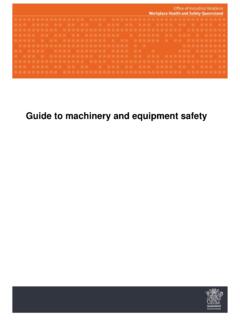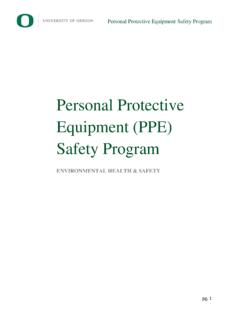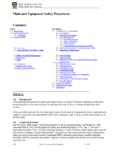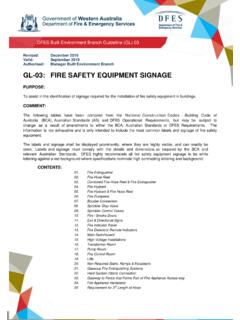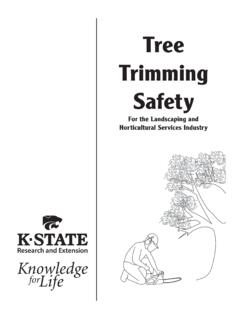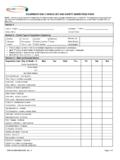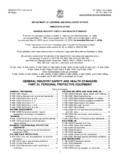Transcription of HEAVY EQUIPMENT SAFETY TRAINING HANDBOOK
1 HEAVY EQUIPMENT SAFETY TRAINING HANDBOOK November 2010 Corresponding Fish and Wildlife Service Manual Chapter: Vehicles and EQUIPMENT Management Part 321 Motor Vehicles and EQUIPMENT Operator Program Originating Office: Division of Contracting and Facilities Management HEAVY EQUIPMENT SAFETY TRAINING HANDBOOK TABLE OF CONTENTS CHAPTER Page INTRODUCTION .. 1 CHAPTER 1. HEAVY EQUIPMENT OPERATOR .. 3 Definition What is HEAVY EQUIPMENT ? What TRAINING is required? How do you sign up for the TRAINING ? Is refresher TRAINING required? What type of personal protective gear must I wear? CHAPTER 2. HEAVY EQUIPMENT OPERATOR Wildland Fire Operations .. 5 Definition Which HEAVY EQUIPMENT operator positions are involved with Wildland Fire Operations? What TRAINING is required?
2 How do you sign up for the TRAINING ? Is refresher TRAINING required? What type of personal protective gear must I wear? CHAPTER 3. NATIONAL HEAVY EQUIPMENT COORDINATOR .. 6 What is the role of the National HEAVY EQUIPMENT Coordinator? What are the duties of the National HEAVY EQUIPMENT Coordinator? CHAPTER 4. REGIONAL HEAVY EQUIPMENT COORDINATOR .. 7 What is the role of the Regional HEAVY EQUIPMENT Coordinator? What are the duties of a Regional HEAVY EQUIPMENT Coordinator? CHAPTER 5. HEAVY EQUIPMENT SAFETY INSTRUCTOR .. 8 Definition Who determines how many HEAVY EQUIPMENT SAFETY Instructors are required to meet the Regional needs? How can an employee become a HEAVY EQUIPMENT SAFETY Instructor? What are the duties of a HEAVY EQUIPMENT SAFETY Instructor? What is the goal of a HEAVY EQUIPMENT SAFETY Instructor?
3 Can the authorization of a HEAVY EQUIPMENT SAFETY Instructor be suspended or revoked? CHAPTER 6. NCTC .. 11 What is role of NCTC for HEAVY EQUIPMENT SAFETY TRAINING ? What future role can NCTC provide? CHAPTER 7. MANUFACTURER-OFFERED HEAVY EQUIPMENT TRAINING .. 12 What is Manufacturer-Offered HEAVY EQUIPMENT TRAINING ? Can Service employees take Manufacturer-Offered HEAVY EQUIPMENT TRAINING ? Will successful completion of these courses authorize a Service employee to operate a piece of HEAVY EQUIPMENT ? CHAPTER 8. LOAD SECUREMENT TRAINING .. 13 What is Load Securement TRAINING ? Who must have Load Securement TRAINING ? How can a Service employee or volunteer obtain Load Securement TRAINING ? APPENDICES .. 14 1 INTRODUCTION The Fish and Wildlife Service (Service) is a land management agency responsible for more than 100 million acres and over 10,000 employees.
4 Because the Service accomplishes a wide variety of operational tasks to support mission goals, it is extremely important that we provide a consistent and effective SAFETY TRAINING program for HEAVY EQUIPMENT operations. The Service has been proactive in the area of HEAVY EQUIPMENT SAFETY TRAINING since 1979 when we first established a TRAINING policy for HEAVY EQUIPMENT operators. We designed the TRAINING program to meet policy standards and to integrate with mission goals. We have refined this program throughout the years to reflect changes in technology and field practices (see Appendix C. HEAVY EQUIPMENT SAFETY TRAINING HISTORY). We use full time, part time, seasonal, and volunteer operators to accomplish projects on the ground level. This range of personnel creates the challenge of providing adequate and timely TRAINING to operators located throughout the country.
5 To accomplish this task, we use a cadre of experienced HEAVY EQUIPMENT operators who have received instructor TRAINING and other necessary resources. The instructors are provided logistical support and TRAINING materials from the Regional HEAVY EQUIPMENT Coordinator who also manages the in the field classroom and operation segments of the program. The National Conservation TRAINING Center (NCTC) in Shepherdstown, WV provides for program administration, web-based pre-class TRAINING , and web-based refresher TRAINING . In 2010 the Service will establish the requirement for employees to successfully complete a refresher TRAINING program every 3 years for each type of EQUIPMENT they operate. Any person who operates Service-owned, leased, rented, or borrowed HEAVY EQUIPMENT (regardless of job series) must take 8 hours of SAFETY TRAINING for each type of EQUIPMENT before they operate the EQUIPMENT .
6 This TRAINING includes 3 hours of pre-class study, 4 hours of classroom instruction, and at minimum, 1 hour of EQUIPMENT operation to demonstrate their ability to apply the safe HEAVY EQUIPMENT operating procedures for the terrain and conditions in their area. After completing the TRAINING , the operator must demonstrate through written exams and a pass/fail instructor evaluation the following knowledge and skills: y The Operator s Manual y Proper methods of fueling, maintenance, and lubrication as required by the manufacturer y Pre-start procedures, which include proper SAFETY checks y Starting and warming up the machine y Proper operational procedures, which include use of all controls y Demonstration of travel maneuvers necessary for the types of terrain they will encounter y Proper hook-up of EQUIPMENT and attachments that may be used with the machine y Operation of the EQUIPMENT with various attachments y Proper shut-down procedures y Proper transportation and load securement procedures as defined in 243 FW 5 y Proper personal protective EQUIPMENT as defined in 241 FW 3 y Service policy as it pertains to HEAVY EQUIPMENT (See Appendix B.)
7 REFERENCES): - 321 FW 1 Operator Requirements and Responsibilities - 243 FW 1 Safe Operation of Motor Vehicles and Motor EQUIPMENT - 243 FW 2 Special Purpose Trucks - 243 FW 3 HEAVY -Duty Motor EQUIPMENT - 243 FW 4 Powered Industrial Trucks - 243 FW 5 Towing, Cargo Carrying, and Load Securement - 243 FW 6 Off-Road Utility Vehicles - 241 FW 3 Personal Protective EQUIPMENT - 242 FW 3 Noise Control and Hearing Loss Prevention 2 Currently there are 11 types of EQUIPMENT for which the Service has developed a SAFETY TRAINING program. They are: y Motor grader, y Self propelled scraper pan, y Skid steer, y Agricultural tractor, y Crawler dozer, y Crawler loader, y Wheeled loader, y Powered industrial trucks (forklift) Classes 1-7, y Excavator, y Backhoe/loader, and y Specialty tracked EQUIPMENT .
8 3 HEAVY EQUIPMENT OPERATOR CHAPTER 1 Definition: As described in Service Manual 321 FW 1, a HEAVY EQUIPMENT operator is: y An employee or volunteer who operates HEAVY duty EQUIPMENT and whose operator duties are specifically mentioned in his or her position description or Volunteer Services Agreement (Optional Form (OF) 301A), or y An individual identified in a Service written agreement ( , Memorandum of Understanding) who operates Service HEAVY EQUIPMENT . What is HEAVY EQUIPMENT ? Table 1-2 in 321 FW gives examples of HEAVY EQUIPMENT : HEAVY Duty Motor EQUIPMENT EQUIPMENT Comments/Examples (if applicable) (a) Crawler-dozers and crawler-loaders (b) Four-wheel-drive loaders Articulating or straight frame (c) Motor graders Articulating or straight frame (d) Draglines (e) Power excavators (f) Motor cranes (g) Agricultural tractors that are: Self-propelled, 2/4 wheel or track driven, More than 20 engine HP, EQUIPMENT designed to furnish power to agricultural/forestry/construction/ industrial tools or attachments, Manufactured with a Roll-Over-Protective-Structure (ROPS), and Defined in 29 CFR (b)(1).
9 (h) Amphibious/soft tracked EQUIPMENT (wheeled or tracked) over 1,900 pounds curb weight including: Weasels Thiokols Roligons Marsh Masters SnowCats Muskegs Gyro-Tracs Geo-Boys Hydro-Axes (i) Self propelled scraper pans, (j) Industrial tractors Front-end loader/backhoes (k) Skid steers, (l) Forklifts Classes 1-7 (m) Industrial powered lift trucks Specialized EQUIPMENT other than that listed in the table above requires a TRAINING program that meets the same standards as those required in 321 FW 1. Contact your Regional HEAVY EQUIPMENT Coordinator to develop a program to meet those needs. 4 This standard includes all HEAVY EQUIPMENT that is Service-owned, leased, rented, or borrowed and is operated by Service employees or volunteers.
10 What TRAINING is required? 321 FW 1 identifies the TRAINING required for all types of HEAVY EQUIPMENT and describes the supervisor s responsibility to document the type and extent of TRAINING for each operator using FWS Form 3-2267 (See APPENDIX D FORMS). y The Service does not offer TRAINING for motor cranes. Operators for that type of EQUIPMENT must be licensed by the State for crane certification, or, if State licensing is not required, must have successfully completed a nationwide crane certification program meeting Federal OSHA 29 CFR and ASME/ANSI standards. EQUIPMENT manufactured as draglines will maintain the functionality of a dragline. If you use a dragline for craning operations, the operator and EQUIPMENT must meet the standards cited above. Dragline operators must complete a manufacturer-offered SAFETY TRAINING program containing, at minimum, the requirements for HEAVY EQUIPMENT SAFETY TRAINING described in 321 FW 1.



